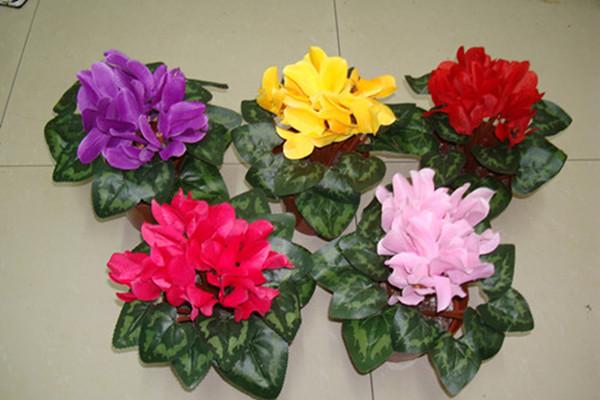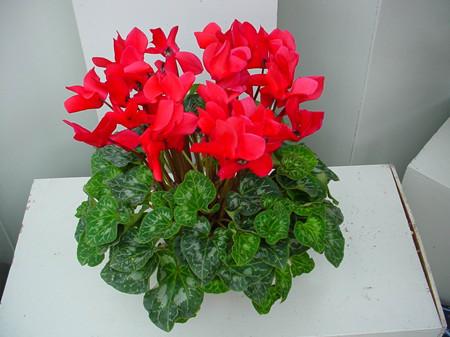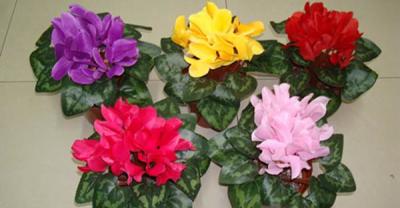Cyclamen persicum L.
Cyclamen, also known as a crown, rabbit ear flower, fire bonflower, radish begonia, primrose and so on, is a kind of perennial herbaceous bulb flower of cyclamen genus of Primulaceae. Cyclamen, with flat round fleshy stem, magnificent shape, plant height of 20 to 30 cm, the base of the hypertrophic tuber is oblate or spherical (commonly known as bulb). The annual bulb is light dark red, the old bulb is purplish black, the outer cork is corky, and there are many slender whisker roots at the bottom of the bulb.

Cyclamen has a good shape, moderate height, luxuriant flowers, bright colors, long florescence, unique flower shape, and some sweet fragrance. In recent years, it has risen in the cultivation of horticultural flowers and has become a leader in decorating the house, living room and beautifying the interior in early spring. here is a detailed introduction to how cyclamen is raised:
1. Soil selection of cyclamen culture
The culture soil can be prepared with 3 humus soil, 2 forest rotten leaf soil, 2 furnace ash, 2 river sand (sandy vegetable garden soil), 1 mature compost, and properly mixed with calcium superphosphate and other chemicals. This kind of soil, loose and fertile, is suitable for cyclamen to grow. During cultivation, the fumigation method must be used in the cultivation soil, and the high temperature disinfection must be carried out strictly. The cultivation container should be gradually enlarged according to the size of the bulb, and the small seedlings should not be cultivated in large pots.
Cymbal
two。 Fertilization method of cyclamen culture
Cyclamen like fertilizer, but do not like thick fertilizer, in addition to turning the basin to change the soil to apply some basic fertilizer, generally can be fertilized once every ten days and half a month, pay attention to thin fertilizer diligently. After planting, during the vegetative growth period for several months, organic liquid fertilizer can be applied with a concentration of 1, 6, 1, 8, 1 and 10, and muddy water is used to water the flowers. after summer, if the temperature can not be controlled, fertilizer should be stopped.
3. Watering method of cyclamen culture
Cyclamen can withstand drought. But the soil should be kept moist during the growing season, and pay attention to the fact that there is no water in the basin. Cyclamen does not like soil that is too wet, watering it frequently and less. If summer is not dormant, normal watering can be carried out to keep the basin soil dry. After the Beginning of Autumn, cyclamen entered the period of human reproductive growth, at this time to apply phosphorus and potassium fertilizer. If it is found that the plant is overgrown, apply calcium superphosphate or plant ash extract to control vegetative growth. promote flower bud differentiation, bud pregnancy and flowering.

4. Temperature requirements of cyclamen culture
The suitable growth temperature of cyclamen in winter is 10: 22 ℃, and the temperature difference between daytime and night should be 8: 10 ℃. It can also bloom when the night temperature is controlled at 7: 8 ℃, but the florescence will be delayed slightly, but if it is lower than 6 ℃, it can not blossom normally.
5. Lighting requirements of cyclamen culture
Temperature and light have certain effects on the growth and development of cyclamen. In the whole growth process, it is mainly from the temperature to consider prolonging the florescence. After the flowers are reduced by the end of April, the potted flowers should be removed from the greenhouse and kept in a ventilated and cool place with scattered light. Climate change, suitable temperature and light will also make cyclamen grow a batch of scape and continue to blossom. In the Yangtze River basin and its southern area, the leaves gradually turn yellow after May, which is a reflection of the rising temperature, so watering should be controlled at this time. In summer, conditional cooling equipment should be used to lower the ambient temperature.

Cymbal
The general family should put the potted flowers in an indoor ventilated and cool place during the day and ventilate on the balcony at night. If the temperature does not exceed 20 ℃, fertilizer and water management can be carried out, and cyclamen will grow slowly. In the hottest period when all the leaves withered in July, the flowerpots should be placed in a low-temperature, ventilated environment, and the soil should not be too dry to let them dormant for a month. After August, cyclamen will be placed in the temperature and light environment suitable for growth, slightly watered, so that the bulb can sprout as soon as possible, cyclamen can sprout ahead of time. At the end of August, turning the basin and changing the soil were carried out to cut off the abortive roots, so that the plants could grow vigorously under good ecological conditions.
6. Control methods of diseases and insect pests in cyclamen culture
Cyclamen is vulnerable to aphids, red spiders and leaf curlers in the growing season, so attention should be paid to prevention and control. At the same time, the roots of cyclamen are susceptible to nematode diseases, and pesticides such as carbofuran can be used for basin soil disinfection, with a dosage of 2 grams per pot (0.1% of the soil weight) and mixed into the soil. Cyclamen is also prone to soft rot, leaf spot, fungal atrophy and anthrax. During the onset of the disease, 0.01% concentration of topiramate aqueous solution, or 0.15%-0.2% concentration of thiophanate and chlorothalonil clear water solution can be used for effective spraying.

7. Matters needing attention in cyclamen culture
When the temperature exceeds 28 ℃ in summer, cyclamen seeds begin to dormancy, the dormancy period is not well managed, and the bulbs are easy to dry or rot. How to spend the summer safely is a difficult point in cyclamen cultivation.
It is the best way to spend the summer with strong seedlings. The annual seedlings sown have vigorous growth and weak dormancy tendency in summer. it is necessary to strengthen fertilizer and water management before the beginning of summer to form strong seedlings so as to make the leaves thick, many leaves, thick color and luster. This kind of seedling has strong heat resistance, and it is necessary to do a good job of cooling and dampness reduction at the same time. Cover the sunshade net, increase ventilation, apply thin fertilizer frequently, and spray water around the plant to cool down. After spending the summer in late August, cyclamen enters the growing period, so it is necessary to strengthen fertilizer and water management.
Cymbal
For more than two-year-old balls, they should also be moved to shade and rain shelter in summer, and often spray water around to cool down, strictly control the watering in the basin, rather dry than wet, generally pour 2-3% water into the dry basin for about 10 days, never be flooded or caught in the rain, otherwise the bulbs will rot. Until early September, gradually resume watering, two or three weeks later, can be moved to the sun, and normal application of fertilizer water, during the Spring Festival can blossom as scheduled. After the cyclamen leaves fall off completely, dig out the bulbs, remove the soil and dead leaves, store them in a cool and ventilated place indoors, put them back into the basin after autumn, and apply fertilizer and water reasonably to restore vitality. Cyclamen breaks dormancy but artificially creates a cool environment, such as in an air-conditioned room. Keep the temperature at 20-30 ℃ and water it normally, cyclamen will continue to grow, sprout new leaves and produce new flowers. The original environment will be restored after autumn.

8. Breeding methods of cyclamen culture
(1) sowing and reproduction: cyclamen seeds, especially hybrid seeds, are difficult to germinate if the seeds themselves are withered. Before sowing, the seeds should be disinfected with 75% alcohol, washed with water, then disinfected in 1% mercury and 10% potassium dihydrogen phosphate solution, then washed with water, and then soaked in warm water of 35-40 ℃ for 24 hours before sowing. Or wrap the full seeds in gauze, soak in 24 ℃ warm water for 12 to 24 hours, scrub the seed coat clean, and then sow the seeds. This method is relatively simple, but the germination effect is worse than the previous one.
The sowing soil can be used for 2 parts of vermiculite, 2 parts of peat soil and 1 part of fine sand, which can be mixed evenly and then sown, or the screened humus soil under deciduous broad-leaved forest can be used directly. The distance between seeds during sowing is 1-2 cm, and the soil is 0.5-0.7 cm after sowing. After soaking in water, it is placed in a dark place to germinate (cyclamen is a completely dark sprouting plant). The temperature is controlled at 18 ℃ and the humidity is controlled at about 90%. In order to maintain humidity, the acupoint plate can be wrapped in plastic film and can sprout in about 20 days. Seedlings emerged in 35-40 days, and the emergence rate was more than 90%.
(2) Stem cutting propagation: it is generally carried out from 1 to 15 months after flowering in spring or from the end of August to the end of September. All bulbs with more than 3 cm in diameter and more than two bud eyes can be divided. The principle of segmentation is to ensure that there is a bud hole on each piece. The cutting knife should be sterilized to prevent the virus from infecting. When cutting, cut down directly to the root. The incision is treated with plant ash and dried before planting.

Like my work, remember to like and follow!
- Prev

Planting method and Propagation of Flowers-asparagus
Asparagus means "gentle bamboo". It is called "bamboo" but not bamboo. It is called asparagus because of its elegant posture, beautiful leaf shape and bamboo-like stem nodes. Wen.
- Next

How to grow lotus seeds
Lotus is very suitable for summer farming plants, and the general plant is different, its growth environment has water, in summer gives a natural cool feeling, and lotus seeds...
Related
- Fuxing push coffee new agricultural production and marketing class: lack of small-scale processing plants
- Jujube rice field leisure farm deep ploughing Yilan for five years to create a space for organic food and play
- Nongyu Farm-A trial of organic papaya for brave women with advanced technology
- Four points for attention in the prevention and control of diseases and insect pests of edible fungi
- How to add nutrient solution to Edible Fungi
- Is there any good way to control edible fungus mites?
- Open Inoculation Technology of Edible Fungi
- Is there any clever way to use fertilizer for edible fungus in winter?
- What agents are used to kill the pathogens of edible fungi in the mushroom shed?
- Rapid drying of Edible Fungi

